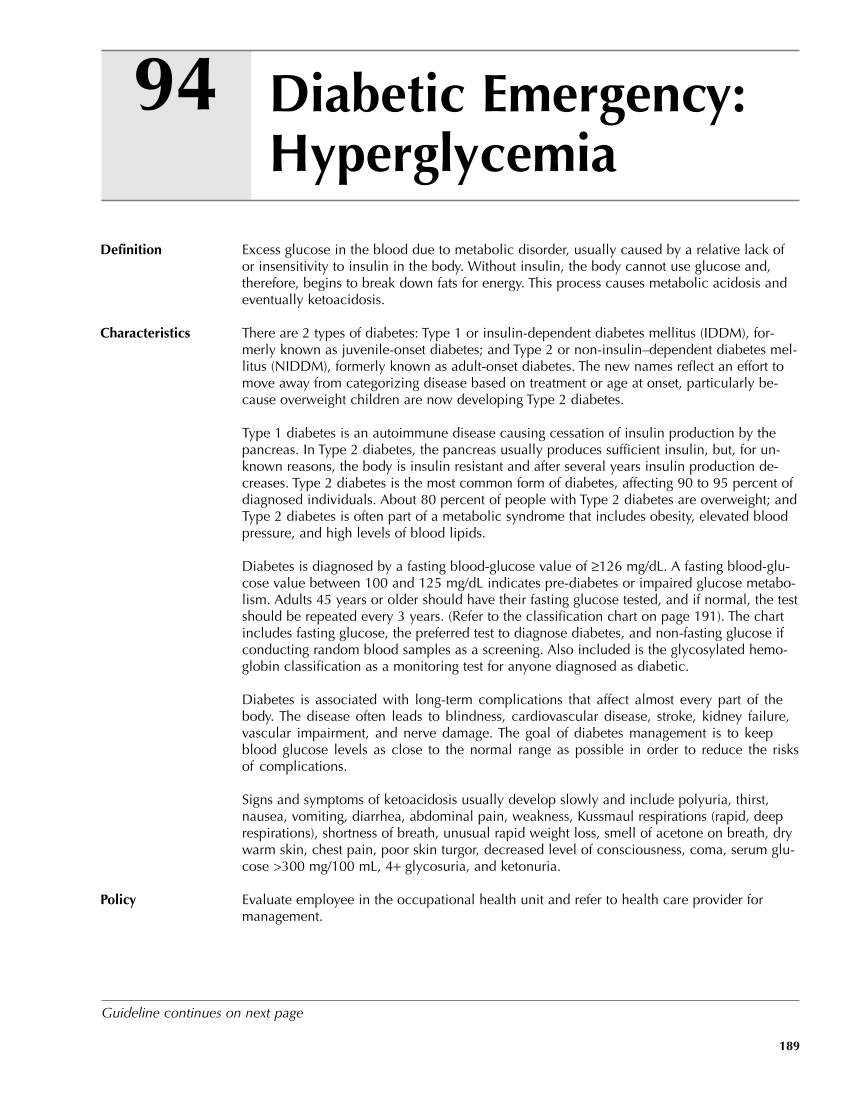189 Diabetic Emergency: Hyperglycemia 94 Definition Excess glucose in the blood due to metabolic disorder, usually caused by a relative lack of or insensitivity to insulin in the body. Without insulin, the body cannot use glucose and, therefore, begins to break down fats for energy. This process causes metabolic acidosis and eventually ketoacidosis. Characteristics There are 2 types of diabetes: Type 1 or insulin-dependent diabetes mellitus (IDDM), for- merly known as juvenile-onset diabetes and Type 2 or non-insulin–dependent diabetes mel- litus (NIDDM), formerly known as adult-onset diabetes. The new names reflect an effort to move away from categorizing disease based on treatment or age at onset, particularly be- cause overweight children are now developing Type 2 diabetes. Type 1 diabetes is an autoimmune disease causing cessation of insulin production by the pancreas. In Type 2 diabetes, the pancreas usually produces sufficient insulin, but, for un- known reasons, the body is insulin resistant and after several years insulin production de- creases. Type 2 diabetes is the most common form of diabetes, affecting 90 to 95 percent of diagnosed individuals. About 80 percent of people with Type 2 diabetes are overweight and Type 2 diabetes is often part of a metabolic syndrome that includes obesity, elevated blood pressure, and high levels of blood lipids. Diabetes is diagnosed by a fasting blood-glucose value of ≥126 mg/dL. A fasting blood-glu- cose value between 100 and 125 mg/dL indicates pre-diabetes or impaired glucose metabo- lism. Adults 45 years or older should have their fasting glucose tested, and if normal, the test should be repeated every 3 years. (Refer to the classification chart on page 191). The chart includes fasting glucose, the preferred test to diagnose diabetes, and non-fasting glucose if conducting random blood samples as a screening. Also included is the glycosylated hemo- globin classification as a monitoring test for anyone diagnosed as diabetic. Diabetes is associated with long-term complications that affect almost every part of the body. The disease often leads to blindness, cardiovascular disease, stroke, kidney failure, vascular impairment, and nerve damage. The goal of diabetes management is to keep blood glucose levels as close to the normal range as possible in order to reduce the risks of complications. Signs and symptoms of ketoacidosis usually develop slowly and include polyuria, thirst, nausea, vomiting, diarrhea, abdominal pain, weakness, Kussmaul respirations (rapid, deep respirations), shortness of breath, unusual rapid weight loss, smell of acetone on breath, dry warm skin, chest pain, poor skin turgor, decreased level of consciousness, coma, serum glu- cose 300 mg/100 mL, 4+ glycosuria, and ketonuria. Policy Evaluate employee in the occupational health unit and refer to health care provider for management. Guideline continues on next page
Purchased from OEM Press by (ge corporate access). (C) 2013 OEM Health Information, Inc. All rights reserved.












































































































































































































































































































































































































































